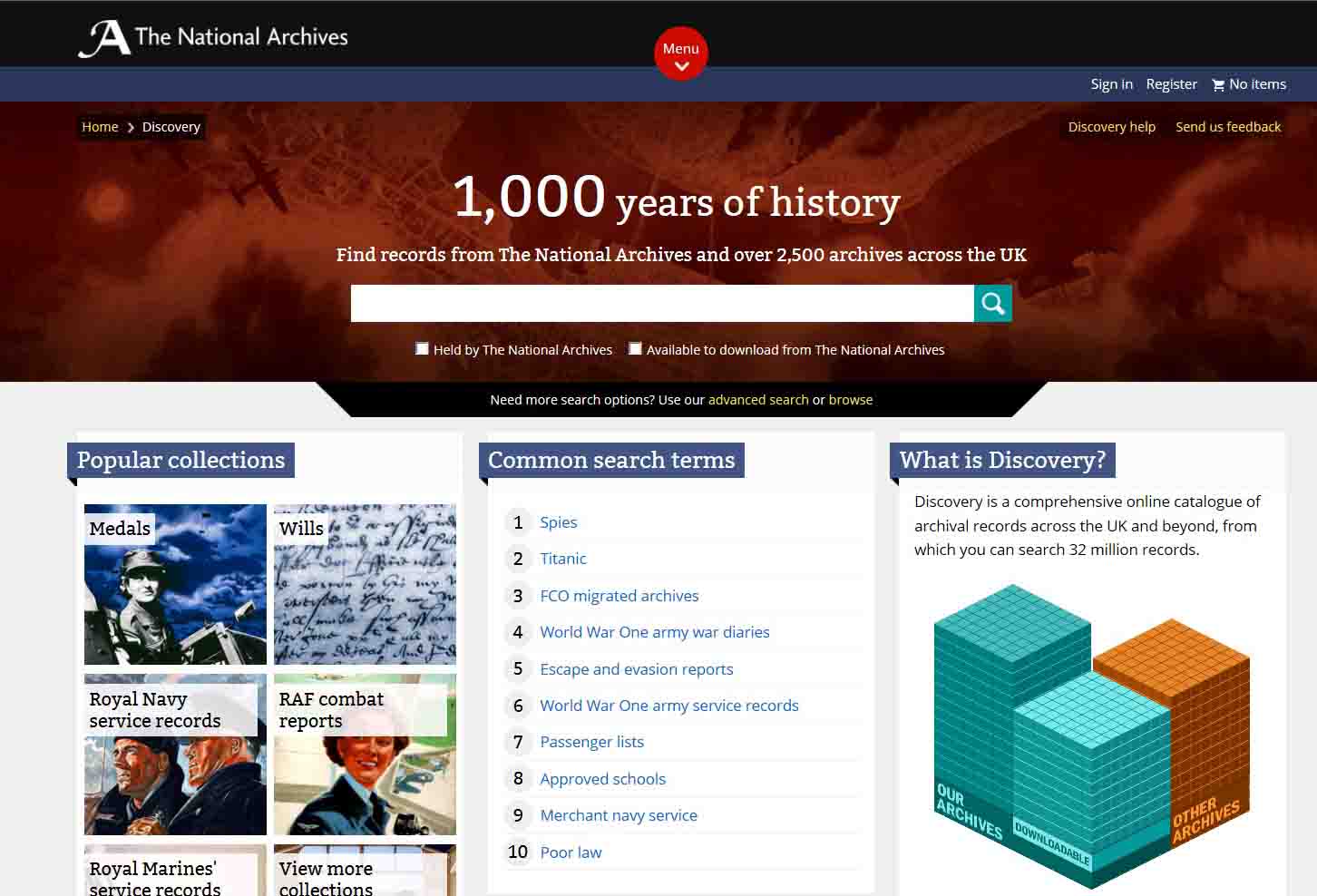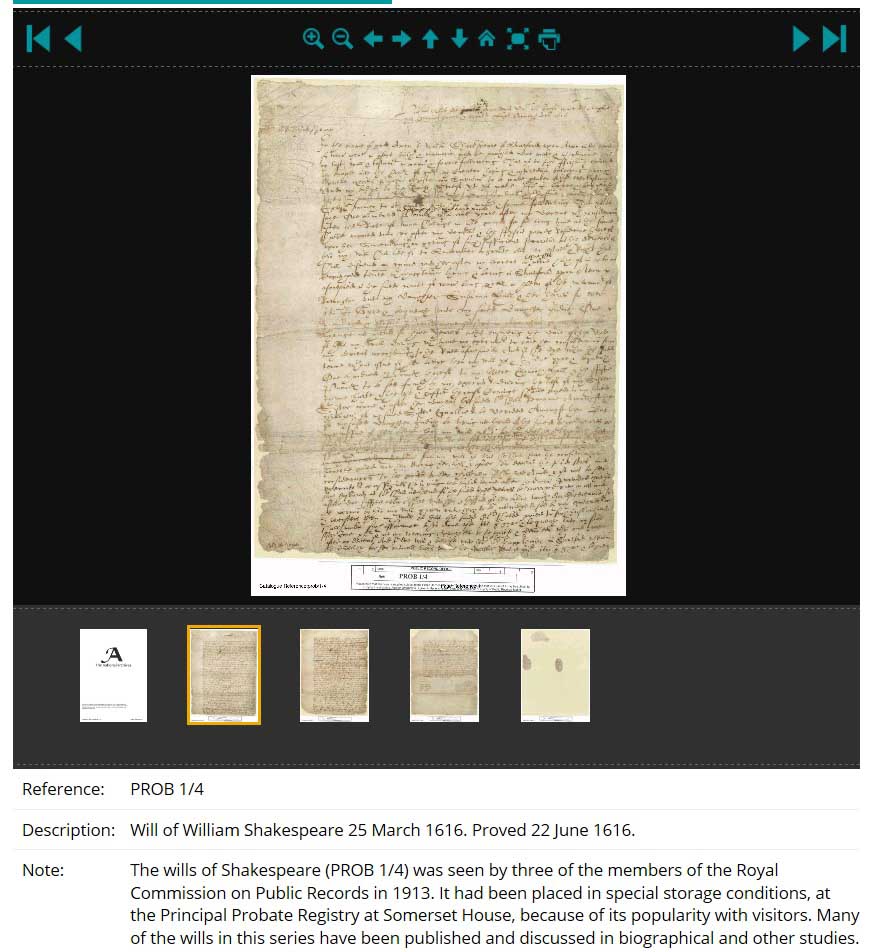
Screenshot of Discovery homepage
In my last blog post I told you about the work we have been doing to upgrade our catalogue, Discovery. This innovative upgraded version of Discovery has been in ‘beta’ for many months and we are now preparing to put it live. It will fully replace the current version of Discovery on Monday 1 September.
The new version of Discovery enables archive users to search, browse and tag 32 million record descriptions of records held by The National Archives, alongside the collections of over 2,500 archives across the UK.
It now incorporates an extra 10 million records from:
- National Register of Archives (NRA)
- Directory of Archives (ARCHON)
- Access to Archives (A2A)
- Manorial Documents Register (MDR)
Along with adding this data to Discovery, we have also upgraded the platform to make it even easier for researchers around the world to find the information they need.
Features, functionality and improvements
There are now three main data types, the records themselves (records), those that made them (record creators) and where they are held (archives). Discovery enables users to switch between record information, information relating to the creators of records, and contact details for archives – all in one place. You can browse for all of these too.
A new search engine, enhanced filters and improved advanced search features mean that everyone can search and explore archive collections more easily. We have added common search terms on the homepage, which are derived from your most frequent searches.
The ability to search The National Archives’ and other archives’ content is the default setting but you can restrict searches to The National Archives and The National Archives’ digitised content on the homepage, enabling quick and easy access to this material.
We have also added a new and improved image viewer along with improvements to downloading results, sorting and sign in.
We have completely redesigned the user interface to incorporate the new features and functionality. We have also made it responsive so we offer a much better experience across a range of devices.
The methodology we adopted for designing and producing Discovery has been very user focused. We have undertaken extensive engagement and sought feedback throughout the lifecycle of the project, updating, improving and re-testing Discovery as we go. Many of the enhancements have been made based on user feedback and requests.
What is Discovery and how do I use it?
One of the key themes from the feedback has been giving Discovery a stronger identity so you can understand exactly what information is included and how to use it. Some of the concepts and information are also very complex, such as the hierarchy of record collections and what a record creator actually is.
To help with this, we have added elements to the home page such as ‘What is Discovery?’ and added explanatory text throughout to aid understanding. We have also fully updated all our help guidance.
We have explanations about where content is held, especially when it is not available for download. For example, records could be held by The National Archives at Kew or the Royal Armouries Library, Leeds or National Records of Scotland, Edinburgh. This enables you to understand who you need to contact and where you need to go to access these.
Feedback and the future
We will continue to improve Discovery after ‘beta’ is live, and welcome feedback from all our users to help us do this. Please tell us what you think in the comments below– it is such an important part of how we design our digital services. So far, the response has been very positive.
Tim Hitchcock, Professor of Digital History at the University of Sussex said:
‘As a single search box in the centre of a blank page has come to replace the card catalogue, how we find what we need has simply changed. Discovery makes the collections of the National Archives accessible to generations of scholars more familiar with the online than the physical… Discovery represents an important milestone in the process of turning the archive inside out – flattening its hierarchies and allowing it to be read in new ways.’
We are currently working on plans for further major enhancements. We will involve you and keep you updated as these move forward. Making Discovery even bigger, better and bolder…


I find it difficult to use as the subject terms have gone, so for Treasury there are 203,000 entries and even by limiting it by years it is almost impossible to find what you want, for example looking at the administrative history. I thought the terms ‘Open Description/Open Document’, ‘Open Description/Closed Document’ and ‘Closed Description/Closed Document’ were useful and have been replaced. Discovery does not help when you turn up at TNA to find the document is being held by the department or not opened as it should have been.
David – thanks for your comments.
With regard to the Discovery features, the subject categories will return – we have moved to a new search engine and need to test the categories further before we add them back into Discovery.
In terms of closure status, we updated the labels when we made some changes to this feature based on feedback from users.
Hope this helps.
[…] Discovery – bigger, bolder and better! […]
Emma,
Thanks.
David
I have attempted to use the beta site on a number of occasions.
One important interest is the Manorial Documents Register.
I have tried to get the information for the county of Essex on it. On the present website I can discover that there are 656 manors, all on a single web page, and then discover the whereabouts of all the documents for each manor with a description of each document.
When I use the beta site, whatever I do, I cannot find 656 manors on a single page. I find either many more or many fewer.
For me the new website is a complete disaster. It is imossible to learn how to get the information which was easily obtainable before.
Where I attempted to rate it, the attempt failed because my internet provider – BT – could not find the site. The message was “Sorry, the website http://www.sbeta.nationalarchives.gov.uk cannot be found”.
Christopher Fance
Christopher – thanks for your feedback.
First of all, we have no intention of removing or restricting capacity to search across MDR information, and work is already underway to develop a ‘custom search’ which will replicate the advanced search functions present in the current online service.
In meantime, you can find all the manors in Essex as follows:
Go to Advanced search and select the “Record creators” tab.
Search for “essex” and select the creator type “Manors”.
You can sort by “Title – ascending” ito see them alphabetically.
http://discovery.nationalarchives.gov.uk/results/c?_srt=5&_aq=essex&_col=500&_dss=range&_naet=M
As the search works differently to MDR, it returns 657 – the extra hit is Essex manor, Nolfolk.
Before MDR is ‘switched off’ we will naturally ensure that its capabilities are complete and, in so doing, provide a clear link to the ‘custom search’ page. In due course, and as we continue to work on outstanding counties towards a goal of a complete register of manorial documents, we will continue to develop the system, improve existing content, and listen to all feedback on the matter.
Emma
If I search for my 4xgreat-grandfather, Oliver Bateman on A2A there are three relevant records, all held at the Kendal branch of Cumbria Archives. The Cumbria Archives Online Catalogue also gives the same information.. I have seen these records at Kendal.
However Discovery says that the Carlisle branch of the Cumbria Archives is the holder. Any researcher going to Carlisle to consult the records will be disappointed. How often do such problems occur?
Beth
Dear Beth,
Thank you for drawing this to our attention. I am investigating the cause of this issue. You rightly point out that these records are held at Kendal. There is a discrepancy in our database as to their location, and I am unsure at what point it arose. It is likely that it resulted from a physical movement of records which has only been partly accounted for in our system.
We hope to resolve this issue soon, and will attempt to extend the exercise to look for any other instances of the same or similar issues. When the information has been updated, I will post an update to this page. However, it may take some time for the changes to appear.
many thanks,
Jonathan Cates
Dear Jonathan,
Thank you very much for your reply.
As far as I know the documents have been at Kendal for several years. They were correctly catalogued on A2A, which was how I found them, initially in I think 2006. I accessed them at Kendal in 2011 and the Cumbria Archives catalogue says they are still at Kendal.
Best wishes,
Beth.
I cannot find how to download the image viewer to decide what record I want when seeking a name with more than one persons records . please help.
Hi Timothy,
Thanks for your comment.
We can’t answer research requests on the blog, but if you go to our ‘contact us’ page at http://nationalarchives.gov.uk/contact/ you’ll see how to get in touch with our record experts via phone, email or live chat.
Best regards,
Liz.